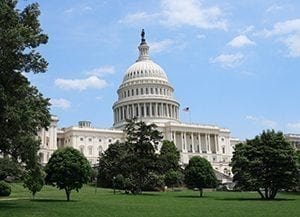
More than 50 congressional aides and staffers learned about the importance of specialty crops, including flowers and plants.
As the House of Representatives presses forward on tax reform, questions about how new legislation will affect small businesses continue to be a central part of the debate.
The Tax Cut and Jobs Act (H.R. 1), introduced in the House last week, would set the tax rate for small business income at 25 percent. The bill, however, limits the amount of income that could be classified at that rate.
Currently, small businesses organized as sole proprietorships, partnerships, limited liability companies and S corporations (all known as “pass-through entities”) are taxed at the individual tax rate. Businesses like these range from small retail stores to real estate conglomerates.
“One of the goals of tax reform is to provide tax relief to small business through the lower tax rates,” explained Shawn McBurney, the Society of American Florists’ senior director of government relations. “Small businesses organized as ‘pass-throughs’ would be taxed at a 25 percent rate; however, there was concern that larger businesses could manipulate the system and organize themselves as a small business in order to obtain the lower rate for their investors.”
To address this, H.R. 1 would limit the 25 percent small-business tax rate to passive investment income, such as interest, and to a portion of active income, including profits and salaries.
“The limit on what portion of active income can be taxed at 25 percent is an effort to prevent abuse of the new reduced rate,” McBurney explained.
Owners and shareholders of pass-through entities would have two options for calculating their tax rates for active income. One method would be to have 30 percent of such income taxed at the 25 percent small business rate while the remaining 70 percent would be subject to individual income tax rates.
The alternative would be to apply a formula based on their level of capital investments that could result in a higher percentage of income being taxed at the 25 percent rate. If a business chose this method, the formula must be applied for five years.
The attempt in the initial draft to prevent manipulation of the new system raised concerns among members of Congress and small business advocates that reform may not help small business owners making less than $200,000, McBurney said. One Republican lawmaker Congress noted that a passive investor would benefit from the reduced 25 percent rate while the owner who would be running the business could be taxed at 39.6 percent.
The National Federation of Independent Business said that the bill left “too many small businesses behind” as it was first written.
To address those concerns, the bill was modified to provide a 9 percent tax rate for pass-throughs on the first $75,000 of taxable net business income.
That rate would be phased-in over five years and would only apply to active owners or shareholders who earn less than $150,000 in taxable income through their business and then phase out at $225,000.
“During the phase-in period, the rate would be 11 percent in 2018 and 2019 and 10 percent in 2020 and 2021,” McBurney explained. “The 9 percent rate would be effective starting in 2022.”
With those changes, the bill was approved by the House Ways & Means Committee and cleared for a vote by the full House, which may happen as soon as this week.
The Senate unveiled its version of tax reform on the same day the House committee approved its version. While the Senate would also reduce the corporate rate from 35 percent to 20 percent, it does so differently. The Senate plan would delay the corporate rate cut beginning in 2019 while the House would make it effective in 2018.
“The Senate bill also differs from the House version in other ways that will make developing a bill both chambers can pass difficult,” McBurney explained. “For example, the Senate bill would retain the estate tax but increase the exemption level to $11 million where the House bill would eliminate the tax after six years.”
Although time is running out quickly, Republican leaders in Congress and President Trump hope to have tax reform enacted by the end of the year, he added.
Look for ongoing coverage of tax reform and other legislative issues important to the floral industry in upcoming issues of E-Brief, Floral Management and SAF’s Week in Review.
Want to make sure lawmakers are representing your point of view? Mark your calendar for SAF’s annual Congressional Action Days, March 12-13.



